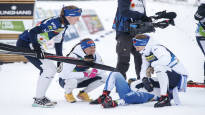Let’s make it clear right away that this comment was written before the men’s 50km race.
Why? Because even though it is Iivo Niskanen the main trip at the World Championships in Planica, the big overall picture of Finnish cross-country skiing has no effect whether Niskanen gets a medal or not.
For the tenth year already, Niskanen is his own chapter not only in Finnish skiing but also in Finnish sports. Four Athlete of the Year selections, three Olympic victories, a world championship and five other prestigious competition medals have brought the 31-year-old Niskanen into the conversation as one of the greatest Finnish athletes of all time.
The series of achievements that started in 2014 has come in an era where the spearhead of Finnish individual sports has been, to put it mildly, narrow.
Let’s forget the stars for a moment
Finnish cross-country skiers have received 23 medals from prestigious competitions held between 2014 and 2023, 13 of which have come from the Olympics. Each of these is associated with either Iivo Niskanen, Krista Pärmäkoski or Kerttu Niskanen name.
Matti Heikkinen the 2017 50 km World Championship bronze is the only personal race medal that doesn’t have a Niskaste or Pärmäkoski wood sign.
When the top of the Finnish national skiing team has been so thin for ten years, it is justified to look at the picture of Finnish skiing on a wider scale.
The following table shows the rankings of Finnish value skiers on personal trips in the years 2014–2023. The rankings of Niskaste and Pärmäkoski have been removed from the table.
As the table shows, behind Niskaste and Pärmäkoski, the top 6 positions (equivalent to the sprint final place) have been rare for Finnish skiers under 30 years old.
Cross mat Hakola reached the top six in the 2018 Olympic sprint (6th). Joni Mäki did the same four years later in Beijing (4:s). Otherwise, it’s been quiet. Also in the World Cup.
When the general level of the team is taken into account, it is no wonder that, for example, the relay medal has not been budgeted for Finns in recent years.
Unrealistic expectations
In Planica, we were able to compete athletically in significantly more equal conditions than a year ago in the Olympic Games remembered as the Beijing corona show. The Beijing Games were a sensational success for the Finns considering the starting points given by the results of the World Cup.
In Planica, the scoreboard more clearly followed the success formula of the season’s World Cup. Only the sprint World Cup bronze winner With Jules Chappaz there is no podium ranking from the current cup season. However, the Frenchman has been sixth at best.
Finnish success still relies heavily on the traditional way of skiing, despite the fact that a year ago in Beijing, both Niskases crossed the finish line in their personal second trip as bronze medalists with skating skis on their feet. This season, the Finns have been on the World Cup podium eight times, seven of them at the end of the traditional race.
Pärmäkoski collected two second places at the Tour de Ski at the turn of the year, one of which came in traditional and the other in free. After these games, Pärmäkoski fell ill, and since then the results have not returned to the level of the Tour.
Kerttu Niskanen came to Planica as the biggest Finnish hope with four World Cup podiums and second place in the Tour de Ski. However, the range of Niskanen’s free results was so large that he was one of the biggest medal favorites with only 30 kilometers.
When Iivo Niskanen’s broken season is added, the starting points were not delicious for Finns.
Compared to Beijing, it was also significant that the pair sprint was not competed in the traditional way of skiing. It automatically narrowed the Finns’ chances of success by two competitions.
The historic danger of zero medals was evident in Planica, although optimism seemed to be in the air from day one. Many felt disappointed when the medal had to wait until the men’s relay day, which turned out to be one of the biggest sensations in Finnish skiing history, considering the starting position.
In reality, the other results were largely in line with the level of results seen in the World Cup, especially after the Tour de Ski.
13 youth World Cup medalists
Let’s go back to the initial guiding idea, what happens behind Niskaste and Pärmäkoski.
Niko Anttola anchored the Finnish relay team to medals with amazing maturity after a 14-year break. The youth world champion, who recently turned 20, is being hailed as the heir to the mantle of Iivo Niskanen.
In terms of Finnish top skiing, a lot rests on Anttola’s shoulders.
In the last ten years, Finland has produced 13 youth World Cup medalists, one of whom has become an adult individual medalist. He is Iivo Niskanen.
Niskanen has made it clear that he is aiming for his fourth Olympic gold in 2026. In order for Finnish cross-country skiing to remain vibrant even after its leading star, the young people must be able to bring significantly more to the table than in recent years.
This primarily means placing at the top or feeling like it in the World Cup. Without an iron-clad, week-to-week result, talking about medals in value competitions is based on wishful thinking, not realism.
The Finnish relay team and sprinter Chappaz showed in Planica that surprises are possible. However, the probabilities are not on the side that the renewal of the medal will be successful from the same starting points after two years.
